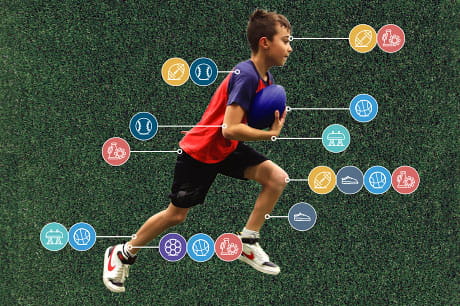Cooped up? Here’s how to exercise (safely) at home.
Doing more at-home workouts during social distancing? Here’s how you can avoid injury.
With gyms and fitness centers temporarily closing their doors and more people self-quarantining in response to the COVID-19 outbreak, many have found themselves looking to start a new workout routine at home. But without the access to trained professionals or ability to attend an in-person class, many of us no longer have someone to watch our form and make corrections or adjustments that help prevent injury.
While doing our due diligence to “flatten the curve,” how can we continue getting that good sweat on (at home) without hurting ourselves?
How to exercise safely
When we go to the gym or a fitness class, there’s usually someone there to watch our form — whether it be a friend or a yoga instructor. But when we’re at home, many of us are relying on a tiny screen or sheet of paper to guide our workouts.
“It’s important that you continue to live an active life while practicing social distancing, also known as physical distancing,” says Dr. Michael Suk, chair of the Geisinger Musculoskeletal Institute and the Department of Orthopaedic Surgery. “But there are some key things you can do to make sure you don’t hurt yourself during an at-home workout.”

Have the right equipment on hand
You’ll want to make sure you have the right equipment on hand, whether it’s weights, a treadmill or resistance bands. You can also get creative and use objects you already have at home as weights — filled water bottles or canned vegetables work great!
If you want to start running, you can also hit the pavement and get some fresh air. Just make sure you have properly fitting shoes for any cardio you’ll be doing to support and protect your feet, knees and back.
Another thing to remember is if you’re using your phone, tablet or the television for a guided video workout, be careful about how you watch the video. It can be very easy to twist your neck when looking up or over at a video.
“Don’t be afraid to come out of a posture to get a better look at what’s happening in the video,” says Dr. Suk.
Don’t try anything new
If you’ve never done intense weightlifting, now isn’t the time to try. “Stick to what you know. If you’re a more advanced athlete and want to advance in your routine, watch videos on any new exercises before you try them,” advises Dr. Suk. Pay attention to posture and form and practice any new moves on their own before jumping right into a workout or adding weight.
Remember to warm up, too. Before any exercise — familiar or new — you should be warming up your muscles to reduce your chance of getting injured.
Don’t overdo it
You may be tempted to work out a little harder than normal if you’re spending more time indoors. While this isn’t necessarily a bad thing, it’s important to listen to your body and make sure you aren’t pushing yourself too hard.
“If you have two intense days in a row of vigorous exercise, you may want to take that third day as a rest day,” says Dr. Suk. Whether you enjoy a little more reading or TV time than usual, do some active foam rolling, take a walk or do some yoga. Your body will thank you. Recovery should be a part of every healthy exercise schedule.
And remember that if you start to feel sick, take care of yourself rather than forcing yourself to exercise. Monitor your symptoms, take medication as recommended by your doctor and avoid interacting with anyone in your house so that they don’t get sick. Make sure you’re feeling better before you begin to exercise again.
Consider working out in short bursts
Working out in short bursts of 10 to 15 minutes, 2 to 3 times a day, is a great way to keep active without overdoing it. It’s also a way to get back into an exercise routine for those who haven’t exercised in a while.
“Exercising in this way will help keep you moving throughout the day while giving your muscles and bones time to adjust to new moves,” says Dr. Suk.
What to do if you get injured during an at-home workout
If you think you’ve injured yourself during an at-home workout, there are a few things you can do to care for yourself right at home:
- Rest. Let your injury heal before you continue to exercise.
- Ice. Apply ice for 10 to 15 minutes at a time to help reduce swelling.
- Compress. Using a gentle compression bandage can help minimize swelling.
- Elevate. To help reduce swelling, elevate an injury.
- Stabilize. Use a brace to help stabilize a joint injury.
- Medicate. Take an anti-inflammatory medication to reduce pain and inflammation.
If at-home treatment doesn’t help reduce the pain or swelling of an at-home workout injury, call your doctor for recommendations or to schedule an appointment to be examined.
“Have fun working out at home and remember to pay attention to how you’re feeling. If your arms are sore, give them a break for the day. If you’re exhausted, try some light activity, like yoga or a walk,” says Dr. Suk.
Next steps:
Make an appointment with Michael Suk, MD
Learn more about orthopaedic and sports medicine care at Geisinger
Looking for COVID-19 info? Visit our online Coronavirus Resource Center

Telemedicine video visits
See your doctor from the comfort of home — from routine care to specialty care
Get virtual care nowCOVID-19 updates: Visit Geisinger's Coronavirus Resource Center for the latest information and helpful resources.




